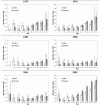The impact of major heat waves on all-cause and cause-specific mortality in France from 1971 to 2003
- PMID: 17468879
- PMCID: PMC2291483
- DOI: 10.1007/s00420-007-0173-4
The impact of major heat waves on all-cause and cause-specific mortality in France from 1971 to 2003
Abstract
Objectives: The aim of the study was to identify the major heat waves (HW) that occurred in France from 1971 to 2003 and describe their impact on all-cause and cause-specific mortality.
Methods: Heat waves were defined as periods of at least three consecutive days when the maximum and the minimum temperature, averaged over the whole France, were simultaneously greater than their respective 95th percentile. The underlying causes of death were regrouped into 18 categories. Heatstroke, hyperthermia and dehydration were assigned to the "heat-related causes" (HRC) category. The numbers of deaths observed (O) during the identified HW were compared to those expected (E) on the basis of the mortality rates reported for the three preceding years.
Results: Six HW were identified from the period 1971 to 2003. They were associated with great excess mortality (from 1,300 to 13,700 deaths). The observations are compatible with a moderate harvesting effect for four of the six HW. The mortality ratios increased with age for subjects aged over 55 years and were higher for women than for men over 75 years. For the six HW, the excess mortality was significant for almost all the causes of death: (1) the greatest excess mortality (O-E) were observed for cardiovascular diseases, neoplasms, respiratory system diseases, HRC, ill-defined conditions and injury and poisoning, and (2) the mortality ratios (O/E) were highest for HRC, respiratory diseases, nervous system diseases, mental disorders, infectious diseases, and endocrine and nutritional diseases.
Conclusions: Heat waves associated with excess mortality are not rare events in this temperate-climate country. The excess mortality is much greater than HRC mortality. Some populations are particularly vulnerable to HW: the elderly, women and people with some specific diseases. However, no segment of the population may be considered protected from the risks associated with HW.
Figures


References
-
- Heat-related deaths--four states, July-August 2001, and United States, 1979–1999. MMWR Morb Mortal Wkly Rep. 2002;51:567–70. - PubMed
-
- Applegate WB, Runyan JW, Jr, Brasfield L, et al. Analysis of the 1980 heat wave in Memphis. J Am Geriatr Soc. 1981;29(8):337–42. - PubMed
-
- Bark N. Deaths of psychiatric patients during heat waves. Psychiatr Serv. 1998;49(8):1088–90. - PubMed
-
- Basu R, Samet JM. Relation between elevated ambient temperature and mortality: a review of the epidemiologic evidence. Epidemiol Rev. 2002;24(2):190–202. - PubMed
-
- Besancenot J. Vagues de chaleur et mortalité dans les grandes agglomérations urbaines. Environnement, risques et santé. 2002;4(1):229–240.
Publication types
MeSH terms
LinkOut - more resources
Full Text Sources

